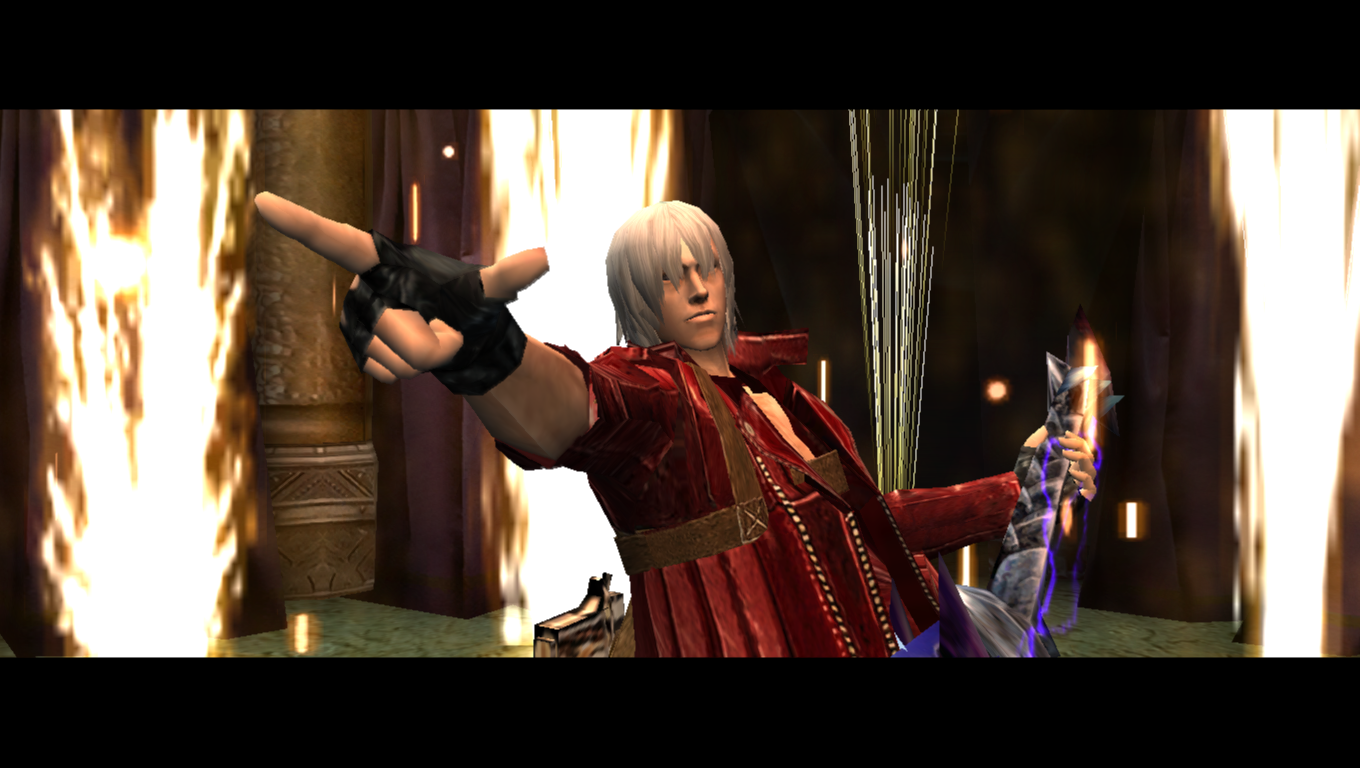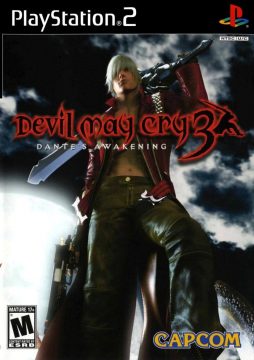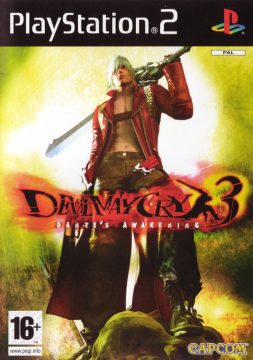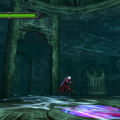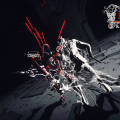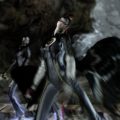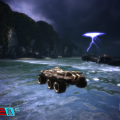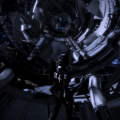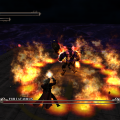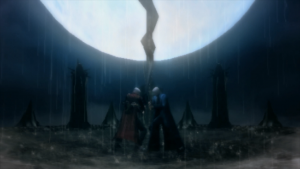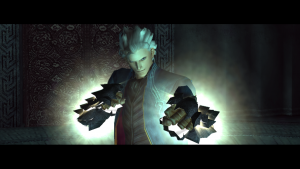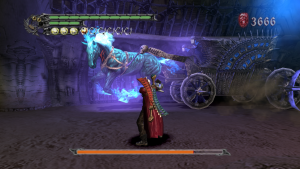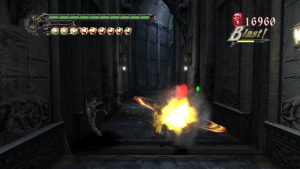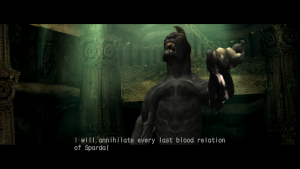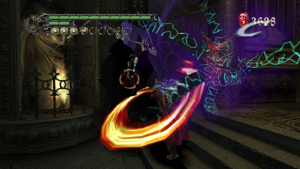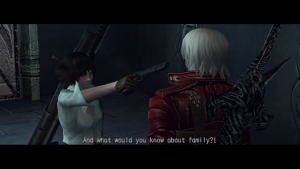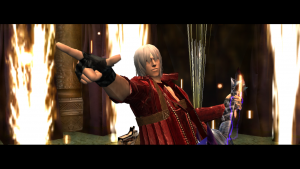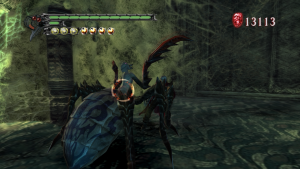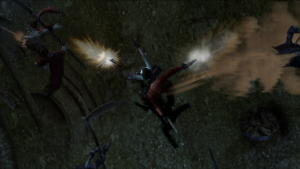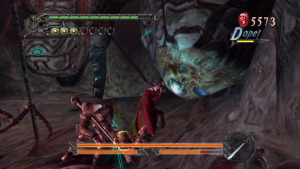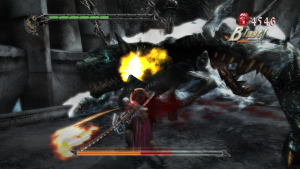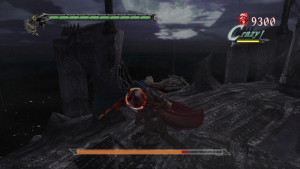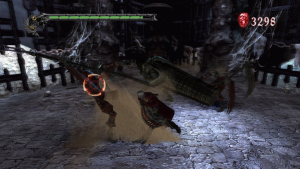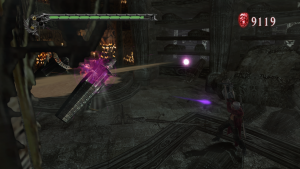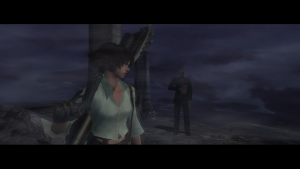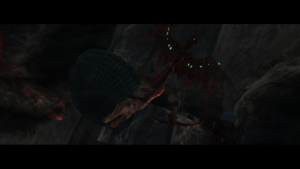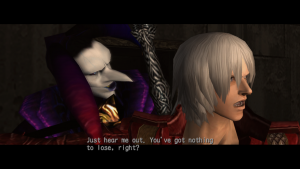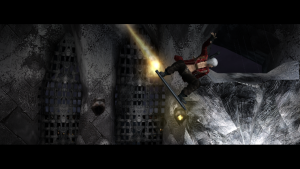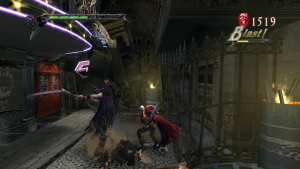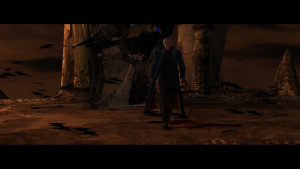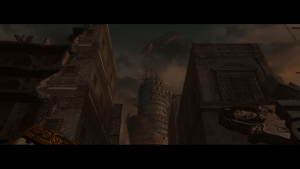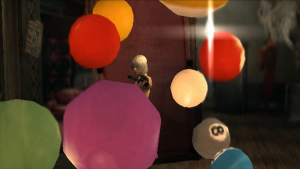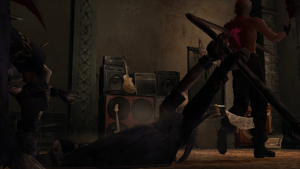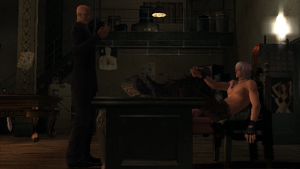- Devil May Cry
- Devil May Cry 2
- Devil May Cry 3: Dante’s Awakening
- Devil May Cry 4
- DmC: Devil May Cry
After Devil May Cry 2‘s messy release and notable dislike among the original’s fans, Itsuno started to reverse course on a lot of decisions and tried to start developing the third game with a framework closer to the original game. On top of that, it was decided to switch back Dante’s personality to cocky instead of stoic, and they got the action director for the movie Versus, Yuji Shimomura, to assist with cutscene direction. Since he had already helped with Onimusha 3 from 2004, he already had a working relationship with Capcom. It’s also worth noting he also stayed on for the next game in the series, did similar work for the Bayonetta series, and even helped out with Metal Gear Solid V, among other projects. Most importantly, the game was turned into a prequel set before either of the previous two games, possibly to distance the series from DMC2 and give Itsuno the chance to put his own creative stamp on the franchise. That was a wise move.
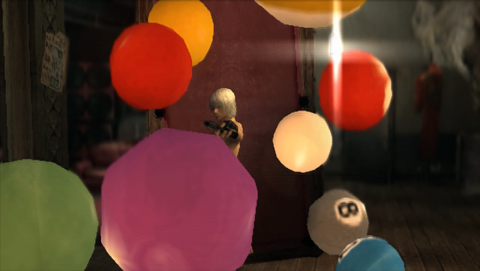
The game sold around 1.3 million copies in the same time frame as DMC2, but the real measure of its success was managing to double that number with the special edition release a year later, which added a significant amount of extras. Those numbers not only meant the game was able to get a wider audience due to good word of mouth, but it was possibly getting repeat purchases from people who simply loved the vanilla version that much. By 2006, three years after release, DMC2 had managed to sale about 1.7 million copies, while DMC3, both the vanilla and special editions combined sold roughly 2.3 million in just a year. The critical reception was also way stronger, with DMC3 getting tons of game of the year nominations. Capcom had a real success.
The new cinematic flair on display helped the game catch eyes quickly. Yuji Shimomura’s cutscene direction is masterful work, creating kinetic and beautifully ridiculous sequences where characters run down massive towers or use a motorcycle as a makeshift weapon. However, they also served gameplay purposes, as many of the actual moves in the cutscenes could be done in game, creating the concept of cutscene Dante. From the first cutscenes, the game dared you to get as good as this version of Dante, and while you wouldn’t be playing billiards in mid-air with a bullet, you could actually re-create a lot of these sequences. This fit in well with the high difficulty and focus on expression through combat, making the player want to get as good as possible and discover the ways all these wild moves could be used within the game’s systems. The focus on style was also increased with the brilliant equitable style system.
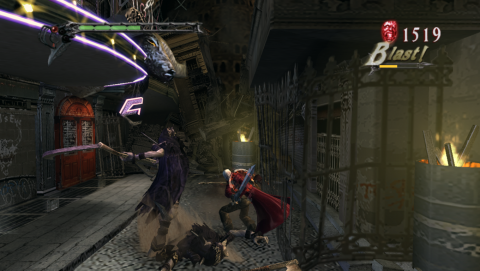
Dante now had a selection of four different styles at the start of the game he could equip and level up through use, giving a new set of actions you could perform with the circle button. Trickster gave dodges and helped you keep your style by avoiding damage, swordmaster put focus on giving you a wider set of moves to build style faster, gunslinger was great for hitting enemies afar to keep style going in slow moments, and royal guard could be used to gain massive style boosts from properly timed countering. Thus, you could further customize Dante to better fit your style of play, and each style was perfectly viable. There are other styles hidden in the game as well, but they were mainly mechanic experiments that didn’t get fully fleshed out, like quicksilver’s time stop and doppelganger’s strange double combo concept.
Devil arms made a return, and they were wildly varied this go, signaled by the first one Dante gets after his basic sword Rebellion was a triple set of ice nunchuks. All of them had a different gimmick to them and could be used for high grade combo work thanks to the previous game’s gun switching being expanded to gun and weapon switching on the fly. Just pick the two guns and two devil arms you wanted to use every mission, and bam, you could switch between them in mid combo to switch things up. It’s also worth noting that guns became much more varied too, including an auto-locking demon gun you could charge for multiple homing shots, and a big hand cannon of a rifle that could put smaller enemies in a stun and fall state in one shot.
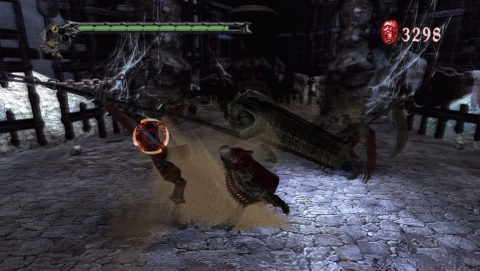
Devil May Cry 3 finally managed to make a complete version of what the original Devil May Cry promised. It was a difficult action game that rewarded mastery with incredible potential for player expression. The game has inspired a community of combo video makers, with some truly mind blowing spectacle that uses every single element of the game’s mechanics, down to canceling, understanding of invincibility frames, and even enemy attack patterns. Better yet, the game does a great job of expressing its more subtle and complex elements, like using special sound cues for enemy attacks when you can’t quite see the attacker on camera, or flashy effects when an abnormal action is made. The second mission stands out for introducing one of the strongest enemy types in the game as a miniboss (a Hell Vanguard) and forcing you into situations where you end up parrying their down scythe swing, informing you that you can make openings during enemy attacks with proper timing.
That said, the US version of the game is much, MUCH more difficult than the Japanese version, trying to make up for how each region reacted to DMC2‘s lacking difficulty. For new players, it doesn’t take long to die enough times to unlock easy mode, which might as well be your average normal mode. It’s not quite as bad as the original game overall, which had several sections made more needlessly frustrating by the poor camera angles. The camera in DMC3 goes back to mostly fixed angles, but the sound design does a lot to help alleviate a lot of potential frustration this could bring, along with a much better lock on system. Instead of attacking in the enemy’s direction automatically or always being locked on, you could swing and fire in whatever direction Dante faced, making the launcher and stinger inputs easier to make in a pitch. Unless you’re using Nevan, there’s rarely a point in the game where you forget Dante’s positioning, and Nevan is a bizarre weapon that usually requires you to be stationary and rapid tap instead.
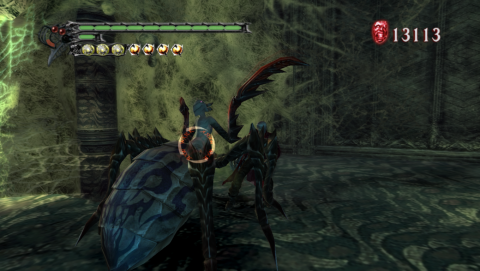
Devil May Cry 3 is a game you could quite literally play for years and not discover everything it has to offer. This isn’t due to the amount of content in the game, but the sheer depth of the mechanics and systems. That said, there is a lot of content to be unlocked by finishing the main campaign, and the special edition also adds in the survival mode Bloody Palace (carried over from Devil May Cry 2 and since become a series staple) and the ability to play through the main campaign as Vergil, one of the game’s major antagonists. It’s really worth the replay, as Vergil’s play style is much more focused on making the most of single hits and punishing enemies. Supporting character Jester also becomes a boss you can fight three times in one of the strangest battles in the whole franchise, revolving around a character who uses barriers and spams energy orbs, then dodges your attacks until he tires and teleports away for you to chase after for big damage. The Special Edition also added a gold mode, which restored the Japanese version’s continue system, giving infinite continues and letting you use gold orbs to instantly revive with full health and devil trigger. The original western release’s system, now selectable as yellow mode, instead uses yellow orbs as limited continues. Can’t forget the inclusion of a turbo mode, letting you play the game 20% faster (somewhat of a series staple now).
The icing on the cake is just how strong the art direction, music, and writing were this time around. The design of the demon tower the majority of the game takes place in is varied and constantly visually interesting, with all sorts of structures and ruins that feel otherworldly yet familiar in some way. Cerberus’ room is a great introduction to what’s ahead, taking hellish architecture and flipping it around into an ice theme. All the demons also have a wide range of themes and styles, with these base sand reapers giving way to living chess pieces, flying blood worms, and even flaming horses with time stop powers. Dante’s devil trigger forms are even specially made for the game, with a new design by Atlus character artist Kazuma Kaneko done in exchange for allowing Dante to appear in Shin Megami Tensei III: Nocturne. It turns Dante’s family linage from generic devils into weird bug people, and it’s a welcome change (though it may not be around for DMC5, due to licensing issues).
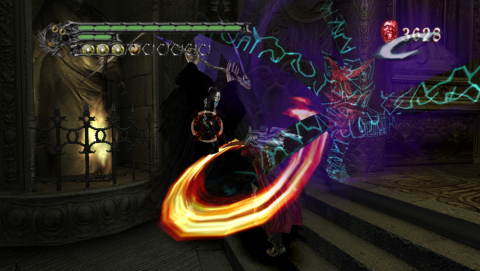
Tetsuya Shibata’s score is absolute master work stuff. The game’s first boss theme is a perfect tone setter that actually fits well with the slower and more cautious pace of the fight, showing a much stronger understanding between the developers and artists on how to make the game feel like a complete whole. Devils Never Cry also remains the series defining theme, getting remixed in all of Dante’s appearances in the Marvel vs Capcom games. It’s blistering, energetic, and ridiculous yet completely sincere, the perfect musical style for the franchise.
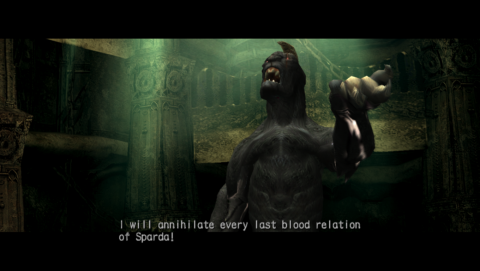
The real surprise is how genuinely strong the writing is. The game tosses out focusing on a generic evil big bad like Mundus, and it takes its time exploring every character in the core cast of four, having a similar structure to DMC2 but fully realized. There’s even a bit of subtlety at points, like Vergil’s motivation being revealed with only a single memorable line about Dante’s inability to protect others, or Lady’s slow emotional breakdown eventually reaching a heart-wrenching end point right before the game’s last battle. The game is all about defining Dante, portraying him as a jaded youth with nothing to fight for and without family, then forcing him to connect with another person and understand his responsibility to stop demons and prevent tragedies like the one he lived through. The ironic part is that Vergil is already dedicated to this goal, but they hit a wall as one changes because of empathy and the other changed supposedly because of tragedy and obsession. Even Arkham, a genuine mustache twirling villain, manages to stick out by his strange mannerisms and the horrific reality of his acts simply to become as powerful as Sparda, the savior of the world. It’s a tight tragedy all about people with deep motivation and conviction reaching points of impossible reconciliation, resulting in the single strongest narrative in the entire franchise.
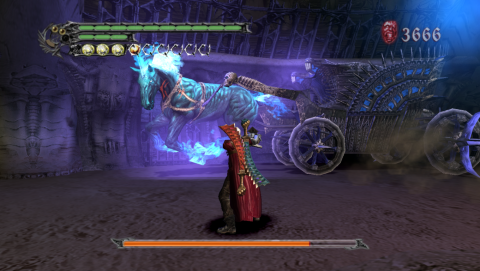
Every single member of the voice cast also gives some truly iconic performances. Reuben Langdon enters the series as the new voice of Dante, and it’s been that way ever since. He ended up going against some of the direction given to him and made his own version of the character, giving him a distinct personality from the two actors before him. You can tell he’s having a load of fun with the lines he gets and comes up with, and that energy extends into his every outing as Dante from here on. Daniel Southworth also turned what was basically a non-character with Vergil into quite possibly the single most popular character in the franchise after Dante. This is partly due to recording his lines while getting over a cold, resulting in a nasally quality in his voice that really makes Vergil stick out and highlight both his serious persona and inner goofiness. Stephanie Cheeva does great supporting work as Lady, selling her more emotional and heated personality to contrast against the two Sparda sons, and Adam D Clerk chews up just the right amount of scenery as Arkham, really drawing out his ridiculous lines about worshiping evil.
With this game, Devil May Cry 3 truly became one of Capcom’s greatest franchises. The first game laid the groundwork for so many other character action games, and then 3 put every single game it inspired to shame with a level of mastery on nearly every level. The game isn’t perfect, of course. A few moments stick out as ill conceived, like the lame shadow Dante fight, but it’s all overshadowed by just how much the game got so right and to such incredible degrees. After this point, though, the series started to go in some weird directions. The next game ended up being rushed through development to appear in the newest generation of consoles while the iron was still hot, and that resulted in one of the more divisive games in the whole series. Well, until the one right after it, but we’ll get there soon enough…
Note: Screenshots for Devil May Cry 1, 2, and 3 were taken from PC releases of the HD Collection. Said collection is fairly accurate to the original versions, but there are notable issues, such as FMVs being stretched out and some menu art not being scaled with the new wider screen support.
